test
Error: Contact form not found.
Error: Contact form not found.
The pros make it look effortless, but if you’ve spent much time on a board, you know that surfing is one of the most skilful, demanding sports out there. Obviously, the best way to get better is to get out and practice. However, if you’re serious about improving your surfing, what you do out of the water is just as important.
Surfing works the entire body, relying on all-over strength, flexibility, stamina and balance. A good land fitness routine incorporates all of these elements, which translates to bigger waves and better tricks in the water. You get much more enjoyment out of your surf time, and the regular workout keeps you sharp during flat spells.
So what’s the best workout for improving your surfing?
One workout that can really step up your game is AntiGravity® Fitness. Designed by a world-famous choreographer, AntiGravity® Fitness is a combination of yoga, dance, acrobatics and aerial arts, performed in special ceiling-mounted hammocks.
What does this have to do with surfing?
Well, the unstable hammocks add an extra layer of intensity to the workout, making it a great supplement to high-performance sports like surfing…
If you’ve ever found yourself stuck in the whitewater, paddling like crazy and getting nowhere fast, you’ll know why paddle strength is important! Without it, you’ll have to work much harder to cut through the water. You’ll have a tough time getting out the back to catch those bigger waves, and you’ll find yourself getting worn out pretty quickly.
A strong paddle makes surfing much easier and much more enjoyable. AntiGravity® helps you to improve your paddle strength and endurance by working the key arm and shoulder muscle groups involved in paddling. Most positions incorporate grips and pull-ups (below), which target the brachialis and brachioradialis muscles in the forearms, and the biceps, triceps, latissimus dorsi and deltoids in the upper arms and shoulders.
Some positions, like the plank, go a step further. Like a regular plank, this position is great for strengthening the upper arms and shoulders. In an AntiGravity® plank, though, your feet are elevated by the Harrison Hammock, which means that those key paddling muscles are working even harder to support and stabilise you.
Effective paddling isn’t just about strength. Your shoulder goes through a wide range of motion as you paddle, and the repetitive movement can put quite a strain on this delicate structure. If your shoulders aren’t strong and flexible enough, you could find yourself with aches, pains, tightness, or even serious injuries.
The rotator cuff is a group of four muscles and various tendons that surround the shoulder joint. It keeps the shoulder stable and allows for the rotating motion you use when paddling. The cuff is vulnerable to overuse, which can lead to inflammation, tendonitis and even tears. A rotator cuff tear can be pretty nasty and difficult to recover from, sometimes requiring surgery and more than likely keeping you out of the water for a good while!
AntiGravity® Fitness has a number of techniques to loosen up those muscles and keep your shoulders flexible and injury-free. My favourite is the reverse prayer (below), which opens up the chest, releases the shoulder muscles and allows your shoulder blades to relax. In the water, this means that your shoulders can move much more freely as you paddle, and you’re much less likely to feel stiff after a long surf.
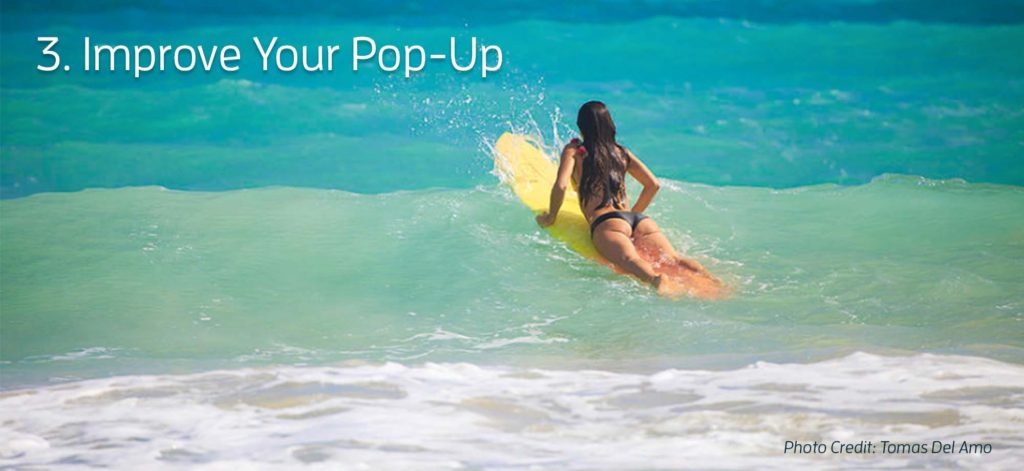 Being able to stand up quickly and smoothly can mean the difference between catching a wave and eating it. If your pop-up is weak or wobbly, you’re not going to have an easy time out there!
Being able to stand up quickly and smoothly can mean the difference between catching a wave and eating it. If your pop-up is weak or wobbly, you’re not going to have an easy time out there!
Push-ups are one of the best exercises for a strong, smooth pop-up. Not only do they strengthen your arm, shoulder and chest muscles, they also train them to perform the pop-up more efficiently by closely replicating the movements involved.
AntiGravity® Fitness takes push-ups (below) to the next level. Similar to the plank, the hammock suspends your feet and puts the emphasis on those upper body muscles, working them harder and more efficiently than a traditional push-up. The result is a strong, dynamic pop-up that looks and feels effortless.
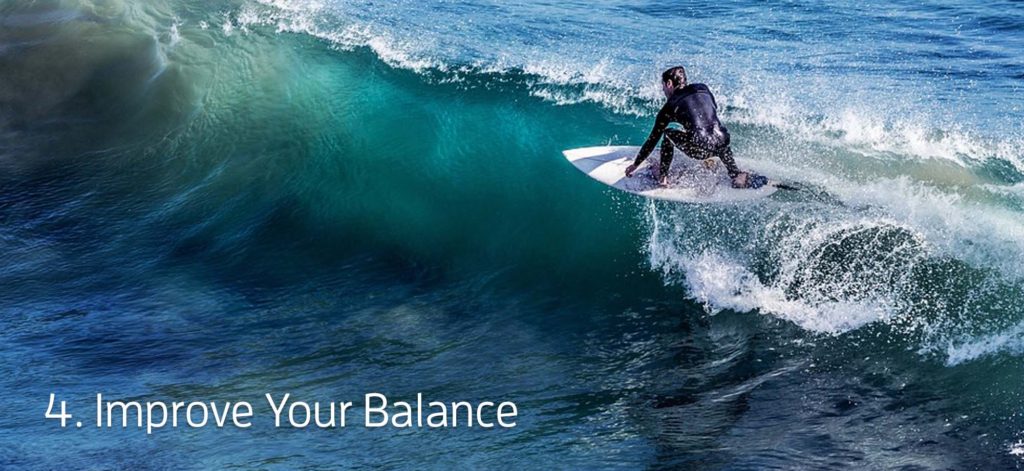 If you’re unsteady on your board, chances are you won’t be spending long on it! If you want to improve your balance, then it’s essential to work on your core strength.
If you’re unsteady on your board, chances are you won’t be spending long on it! If you want to improve your balance, then it’s essential to work on your core strength.
When you’re trying to stay on your board, your vestibular (balance) system is detecting your shifting position and signalling to your core muscles to move in specific ways to keep you upright. This relationship is called co-ordination, and it gets quicker and stronger with practice. However, if your vestibular system is under-used, or your stabilising muscles are weak, then you’re going to have poor co-ordination and shaky balance. On the water, that means regular wipe-outs.
That’s where AntiGravity® Fitness comes in. Because of the three-dimensional movement of the hammock, you’re constantly working against instability as you perform AntiGravity® techniques. This improves co-ordination between the vestibular system and the core muscles, which become stronger and stronger as you use them to keep yourself aligned in the unstable hammock.
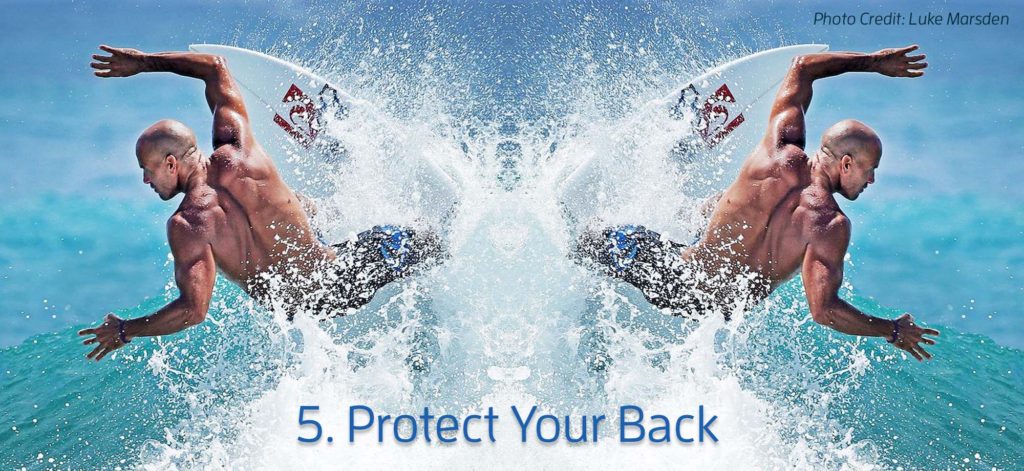 Back pain is one of the most common complaints from surfers. You need to keep up a demanding posture for long periods of time, and movements like reos create lots of twisting and hyper-extension in your lower back.
Back pain is one of the most common complaints from surfers. You need to keep up a demanding posture for long periods of time, and movements like reos create lots of twisting and hyper-extension in your lower back.
This is where AntiGravity® Fitness really excels. Our backs are actually meant to move in all directions, but by the time we get to adulthood, things like sitting, driving and poor posture cause us to lose a lot of our spinal flexibility. So when you’re out on the water, twisting and turning, it can feel painful and unnatural.
In AntiGravity® Fitness classes, we practice backbends like the swan dive (below) and the bell, designed to restore the full range of motion to your spine and protect you from back strain. The hammock supports you in a reversed position, using your own body weight to stretch and lengthen your spine, strengthen the upper back and open up the chest.
As a surfer, flexibility isn’t the only issue that can affect your spinal health. If you feel a deep ache in your lower back when you stand or sit, or a sharp pain when you move your hips, you may be suffering from strain in your quadratus lumborum (QL) or erector spinae (ES) muscles. These are situated either side of your spine at the base of your back, and they’re particularly active when you surf.
I teach a number of AntiGravity® Fitness techniques that focus on building up the lower back. The hip plank and the Mission Impossible (below), are especially effective for strengthening the QL and ES muscles, supporting and protecting your back when you’re on the water.
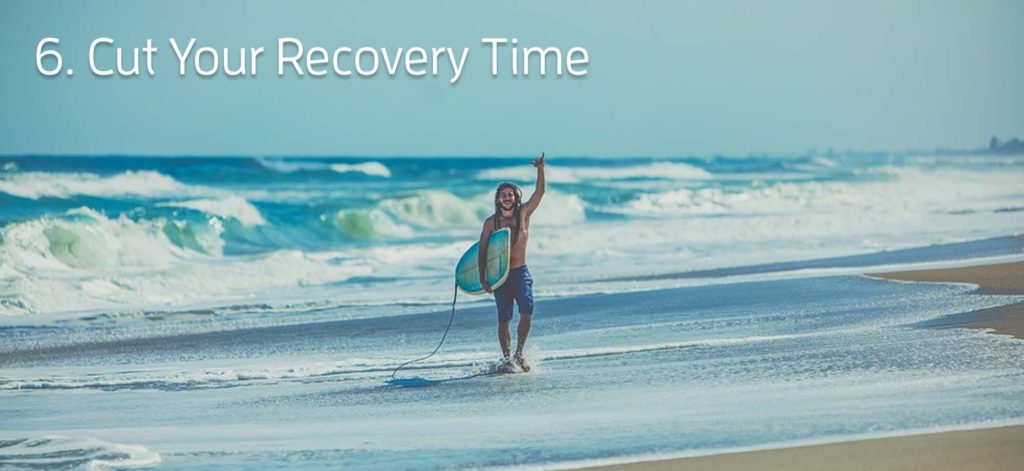 As fun as surfing is, it’s also an intense workout for your whole body. Like any workout, recovery is essential, but I know how tempting it is to ignore those aches and pains when the waves are pumping! AntiGravity® Fitness can help by cutting your recovery time short, leaving you free to spend more time in the water without overdoing it.
As fun as surfing is, it’s also an intense workout for your whole body. Like any workout, recovery is essential, but I know how tempting it is to ignore those aches and pains when the waves are pumping! AntiGravity® Fitness can help by cutting your recovery time short, leaving you free to spend more time in the water without overdoing it.
I teach a two-point AntiGravity® Fitness technique called the Super 2 Combo, which focuses on boosting spinal health and relieving tightness in the back and hips.
Step 1: Zero-Compression Inversions
The Super 2 Combo begins with our famous zero-compression inversions (below). This unique position takes all the pressure off your lower back, allowing your spine to lengthen and decompress. This brings much-needed blood flow and hydration into the discs between the vertebrae, which helps your back to move more freely. You’ll enjoy much greater flexibility and movement in the water, which will keep your back from feeling stiff and sore afterwards.
Step 2: Front Belt Inversions
Tight hip flexor muscles can cause you to pull your pelvis forwards and upwards, shifting your posture and creating a muscle imbalance in your lower back. The second step in the Super 2 Combo is a front belt inversion (below), designed to lengthen and release your hip flexors via deep pressur massage. This opens up the hips, restores balance, relieves pain, and prevents you from experiencing post-surf stiffness in your hips and lower back.
Want to take your surfing up a level? To find out more about the class, call us on 07 575 6070 to book.
Course developed with support of Chris Butler. Photography by Taylor Shea
SaveSave
SaveSave
SaveSave
SaveSave
SaveSaveSaveSave
SaveSave
SaveSave
SaveSaveSaveSave
[vc_row][vc_column width=”1/1″][vc_empty_space height=”200px”][vc_column_text]
There’s no side-stepping or sneaking around it..
You may even avoid it and say “I’ll do it next next time.”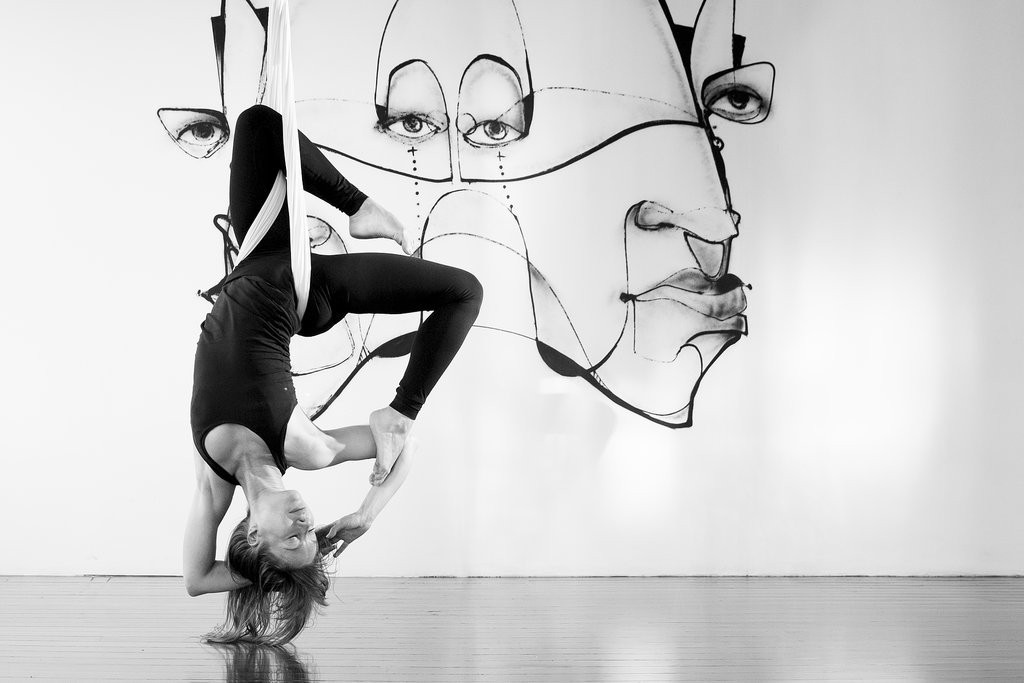
Well I’m here to tell it to you there’s no way to skimp here –
You’ve just got to do it…
Yep…stretching after exercise is a complicated area of science.
There is a big debate around stretching and it’s benefits
but I’m a firm believer in a holistic approach to an active and healthy lifestyle.
I’ve seen first hand how a better range of motion in a joint can help everyday life, and of course I’m not talking about being able to do the splits as a party trick.
In fact before incorporating flexibility routines into my training schedule, I couldn’t sit cross-legged on the floor for longer than a few seconds.
It was so painful!
But enough about me…let’s talk about the fact that:
Flexibility and stretching affects your health in a huge way.
But WHY? And what part does a flexibility routine have to play in having a greater quality of life?
That’s the question I’d like to help answer today. It’s all about the context. ‘Stretching’ is as loose of a term as ‘healthy eating.’ What it means to one person is completely different to another.
Today, I’m going to share some everyday movements you can incorporate into your day
and how a supportive device like an AntiGravity Hammock can help you get a great deal of bang per stretch.
Find out why we have ‘niggles’ and how the can be ironed out with a little time – especially in your hips, shoulders and back.
As promised, find out how just a couple of moves per day can target large muscle groups to allow for greater mobility and flexibility.
That means better performance in life and in your training shoes! Lets jump in and find out all about:
When large groups of muscles don’t work properly i.e are restricted by lack of flexibility, it can cause injuries and a reduced range of motion (a measurement of movement around a joint.)
This basically means a hearty list of problems and ultimately could mean you saying good-bye to the marathon dreams.
And you have worked so hard, so it’s the least thing we want!
As an AntiGravity® instructor it’s my job to help people get a greater quality of life through movement.
One of the ways I like to help is to ask how everyone is feeling, and if anyone is particularly ‘sticky’.
And I usually get a resounding “yes!”
It’s usually these three main culprits:
As we warm up, with a few clicks and pops later, I see relieved faces looking at me, smiling as if they have just un-clogged their bodies.
If you are nodding your head in agreement, then read on to see how just a few gentle to moderate stretches a day could help relieve this tension, and how in our AntiGravity® Hammock we can take these stretches to another level.
With that said, lets take a closer look at our hips first and what part they play in our everyday lives.
We hear it so often that the hips are the most important group of muscles in the human body.
And they are probably right!

In particular the hip flexors and the hip extensors. You will hear us focus on them a lot during class, and for good reason!
Very basically, the hip flexors pull the hips down, whilst the extensors pull the back up, working against each other keeping us in an upright position.
Any time we lunge, bend forwards or backwards we are using our hips as a hinge.
Do you have a tight lower back ? Or feel a shooting pain after sitting or standing for long periods of time?
It could be to do with tight hips. When hip flexors get tight, the hip bones become constantly pulled down creating an unnatural curve in the lower back.
This puts pressure on the spine and can causes problems further down the legs in the knees and ankles.
So runners listen up!
Tightness in the hips ie.constriction will limit the range of motion and the flow of energy.
So when we run, either on the pitch or training for running, tight hips can be a root cause of popular niggling injuries such as:
The good news is, there are many ways to keep your hips healthy and happy. It could be as simple as implementing a few hip stretches into your weekly plan.
Here’s one hip stretch that is a beautiful hip opener – in yoga it is called pigeon pose. So I will refer to it as such from now.
This is a great stretch to be done after exercise to open the hips to prevent injury, say after a long run.
It’s a great way to target individual hip muscles softening stiffness and tension held in the hip area.
We often feel great relief after stretching the hips – as an exercise, feel how tight you are at the end of your run before you stretch, and how light and free you feel afterwards.
It’s as theraputic as it is lengthening for the hips, back, glutes and biceps.
Having a tight knee and a tight lower back could be barriers to comfort in this position.
When we use a hammock to support our leg, gravity gently encourages the knee to open releasing the muscles in the pelvis. The weight of the leg gently stretches the hip-flexor (the big muscles at the front of the pelvis – and believe us it feels like bliss!
Your back is another large and important cluster of ligaments, muscles and tendons that we need to take care of.
One of the major functions of the back muscles is protecting our spine. Now the body does a great job at this.
Sometimes too much of a good job! If our brains sense the spine is in danger, (i.e squished from sitting all day) our muscles will lock and tighten creating painful muscle spasms and inflammation.
Our spine is of course a huge topic we will save for another day. But what we can do today to keep our spine healthy is to keep the spine mobile and capable of day-to-day movement.
These are some common things we hear at Float Fitness, and I can guarantee that we can all relate to at least one of the following:
We may be able to help with these common complaints.(depending on if there is any complication with injury)
I’m not saying that this next stretch is a miracle cure by any means.
However, you may be surprised how implementing a few warm-up stretches can help you ‘free up’ your back allowing for a greater range of motion, and a pain-free day.
One of these great stretches is the cat/cow stretch.
The cat/cow stretch is a lovely freeing movement to prepare the body for exercise – it’s a dynamic stretch best performed before you workout.
Or first thing in the morning before you go to work, even try it in the middle of the day if you can find a quiet spot!
Just a couple of times over the course of the day can be enough to mobilise the spine enough to free tight muscles in the shoulders and middle back.
Breath as you perform this – a long inhale through the nose as you curl into cat, and a long exhale through the mouth as you release into cow.
However, weak wrists and sore knees from running can be barriers to this pose.
Let’s take a look at a cat/cow pose in the hammock. Here, the upper body is nicely supported by the hammock leaving no weight driving down the wrists.
If there’s a place in the body that I hear the most complaints about it’s our knees.
It’s no surprise as they have a lot of hats to wear!
Running, crouching, bending and straightening the legs…so many jobs for such a small joint.
Take walking up the stairs for example. Every step we take upwards the pressure across the knee is four times the weight of the body! So again no surprise that a small tweak could land in surgery.
In fact, in 2013-2014 alone 11,891 kiwis had knee surgery on ACC. Now that’s a good enough reason to take care of this small but terribly important joint.
Some of the most common complaints I hear from my students are: (let’s see if any of these ring true for you too)
The good news is that just a little maintenance can keep our knees healthy and happy.
A combination of strength exercises and stretches will help keep the knee joint healthy and supple.
So how I take care of my students with knee pain is try to get the best alignment possible so the muscles surrounding the joint get the safest workout.
Here is one exercise that is great for strengthening the muscles around the knee – that’s right- the good old lunge.
A great little exercise that can be performed any-where and everywhere!
Let’s take a look at a lunge in the hammock:
The aim of having the hammock is to provide a supported stretch for the groups of muscles that make the knee strong and supple.
Great!
So now you have a couple of common stretches and how we have taken these to our AntiGravity® hammocks.
AntiGravity® Fitness can easily slot in with your fitness goals and can provide a fun and engaging way to get your weekly flexibility training.
We have a large range of static and dynamic stretches all providing length and strength in some of the largest muscle groups in our bodies.In fact, there are over 1000 variations of movements in the AntiGravity® hammock.
To say thanks for reading, we’d love to be able to give you an exclusive offer that will help you in our AntiGravity® journey.
Health and Happiness,
Freyja at Float Fitness
[/vc_column_text][/vc_column][/vc_row]
[vc_row][vc_column width=”1/1″][vc_column_text]
[/vc_column_text][/vc_column][/vc_row][vc_row][vc_column width=”1/1″][vc_column_text] Stretching before and after exercise can and will take your workout routine to the next level…but only when done right!
Stretching before and after exercise can and will take your workout routine to the next level…but only when done right!
But what is the right way?
And what’s the difference between static stretching and dynamic stretching?
We do a little calf stretch here, and the one where you hold your elbow across our body.
(What muscle’s that one stretching again?)
Now all of us have heard lots about the importance of grabbing some exercise – it makes us feel great.
But a lot of us do too, much too soon:
What if by adding a simple 5 minute process to our workouts we could stop this from happening..?
Today I will show you the benefits of applying just a few simple steps to your workout, and how we can amp up your performance with just a few minutes before and after.
We will also cover the differences between these exercises on the floor or in an Antigravity® hammock, including which sports these are PERFECT for…
Whether you are a runner, a surfer, a rock climber or netball player or simply just starting out in your fitness journey…
If you’re anything like me you have your plan mapped out in your head or on paper of up-and-coming training and “Summer goals”
You’re focused on:
But sometimes we can over-look how we are going to help our body recover as we push through and strive for the next level.
Flexibility and stretching is vital to promote proper recover and prevent injury.
So let’s dive in and get you performing at your peak! You may just learn something new as we explore our…
From personal experience I know that even a small amount of stretching can improve muscle condition and flexibility leading to better performance in life and on the track.
Even a little a day results in more efficient muscle contraction and a greater range of motion. But what does this mean for our exercise goals?
I’d love to share my experience with you to help take your health and fitness to the next level.
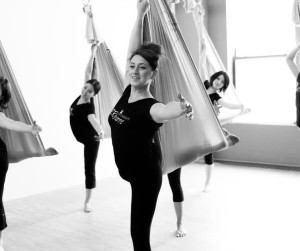 Why Does It Matter To Me?
Why Does It Matter To Me?We see it all too often that a motivated individual with the best intentions of reaching their goals falls short due to injury. We can’t always prevent injuries, but we can do our best to make sure we are training safely.
When we start a new training routine our body is under stress. As we ask more of our body (more weight, longer training) we begin to adapt by growing stronger.
If you don’t exercise often, it could mean that your muscles are de-conditioned, meaning they could need a helping hand to stay strong.
De-conditioned muscles can mean a lot of things, mainly that muscle fibers don’t contract as efficiently as someone who trains regularly.
This can lead to muscular imbalances in turn leading to injury, in turn saying “bye” to the marathon dreams.
The good news is that you can actively avoid injury by incorporating stretching into your workout and as rehabilitation from your usual training regime.
No matter your athletic ability – pro or just starting out – a good flexibility routine can bring help to bring you closer to your fitness goals.
How often and the methods you use to stretch are affected by what you’d like to achieve. If you are looking at stretching to reach your fitness goals faster, this is the article for you.
Please Note : Stretching for injury rehabilitation is very different, and we advise if you have an injury to always see a health professional.
Let’s look at some stretches you can implement into your own exercise routine.
Firstly though, let’s look at why stretching is key to maintaining a healthy body and where it can fit in with your overall fitness goals.
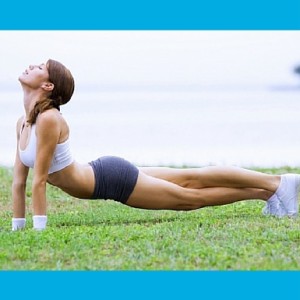 Flexibility and where it fits into your fitness goals
Flexibility and where it fits into your fitness goalsThere are three main components of fitness:
Simply put, optimum fitness can’t be achieved unless there is balance between the three components.
For Example:
If a marathon runner chose to neglect strength training, muscular imbalances in the core and legs could cause injury.
The same if a weight lifter only focused on strength training, they would quickly find they built a body with a reduced range of motion.
From personal experience, I know that a flexibility routine can help take your health and fitness to the next level.
So, we know flexibility training is important, so lets look at some benefits of stretching in detail.
In a health and fitness context, stretching is the relaxation and lengthening of a muscle. We can use this relaxation reflex to improve flexibility in a careful and controlled way.
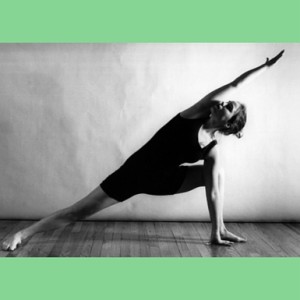 This gentle lengthening brings out responses in the body including:
This gentle lengthening brings out responses in the body including:
Read on to look at these in more detail…
A Greater Range Of Motion
When stretching, all the muscles, tendons and connective tissue are lengthened. Tight muscles are much more susceptible to to muscle strain putting you out of action!
Tight muscles can also lead to imbalances in the body’s alignment resulting in muscle strain.
Better Posture
Poor posture is caused by muscular imbalances and can really prevent your body working at optimal levels. If you sit at a desk, drive, even stand all day it is especially important to make sure your workout routine is balanced with a flexibility program that reduces these imbalances.
Increasing blood flow moving toxins from the joint
As you stretch, you encourage blood flow around the joint bringing vital nutrients to the muscle and tendon structures which may contribute to better function and elasticity.
As blood flow increases, your body can draw away toxins caused by inflammation and fatigue.
Burns Calories
Yes you can burn calories from stretching! Especially if you integrate one or two hour long sessions into your weekly routine.
Reduces Muscle Soreness from Exercise
Effective post workout stretching relieves the muscles you just worked. Blood flow and nutrient flow is increased reducing the effects of DOMS (delayed onset of muscle soreness)
Aids in Mental and Physical relaxation
Some stretching routines promote deep and effective breathing which helps clear the mind of negative thoughts. Moving the diaphragm during breath can clear stress hormones from the blood bringing an overall feeling of calm. Dr. Libby Weaver, renowned speaker, author and nutritionist supports this theory, and recommends diaphragmatic breathing as an important tool in living a stress-free life.
“Long, slow belly breathing expands the muscles in your diaphragm, expanding the lung’s air pockets, stimulating our relaxation response.”
Dr. Libby Weaver
(BHSc (N&D) (Hons) PhD)
Great, so now we understand the benefits!
To begin to understand how and why we stretch lets look at the two different types of stretches and where they fit into your workout.
I’m not saying the stretch in the hammock will replace the stretch on the floor. In fact, they compliment each other !
Your body remembers what correct alignment feels like in the the hammock, than takes it to your daily life outside the hammock.
So let’s look at the two basic types of stretching; static and dynamic.
Dynamic Stretching
Dynamic stretching is a controlled movement that takes you gently to the limits of your range of motion.
These are best performed at the beginning of your workout.
Say you are training for a marathon. You may stop after 3 minutes of gentle jogging and perform some slow lunges and hip circles to encourage blood flow and relax the muscles before you take on the bulk of your run.
Here is an example of a dynamic stretch you can do to warm up the hips before you start your exercise :
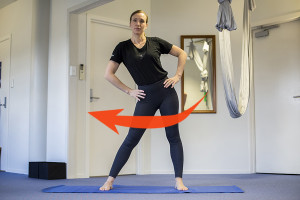
Standing hip rotations are a great example of a dynamic stretch.
Follow these directions for proper execution:
Now let’s check out the this movement in the AntiGravity® Hammock – a supportive device that allows our hips to have a wider circle of movement.
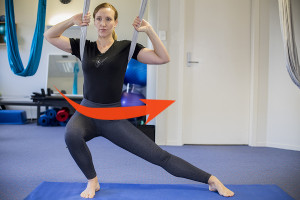
As the hammock takes the weight of the upper body, the hips can be allowed to circle wider without being under compression. It’s a gyroscopic movement that uses the hip’s full range of motion to gently warm up and release our middle body.
Static Stretching
This is a slow, gradual and controlled stretch performed AFTER exercise (don’t use this before warming up or before a strength routine as it could lead to injury and reduced performance)
Static stretching is excellent for lengthening muscles. Say if you are working towards the splits a controlled warm up, then time spent with static stretches will get you there quite quickly!
Take time at the end of training to wind down and stretch will quieten your heart beat and slow your mind – feel a huge sense of calm wash over you as all the feel-good hormones released from exercise come into play.
It’s a great place to take a bit of ‘me’ time!
Take your time and breath into stretches to get more length.
Here’s an example of a down dog, a great static stretch that lengthens the lower back and hamstrings, 2 key groups of muscles that can suffer from lack of stretching post – exercise.
Downward Facing Dog
An incredible all-body stretch for gentle static stretch.
(Please avoid down dog if you have any of the following: Carpel Tunnel Syndrome, Pregnancy, High Blood Pressure)
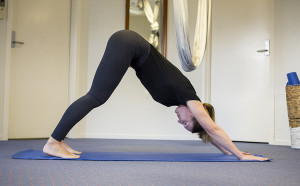
How to:
To take a break bend the knees – aim for 3 rounds of a few breaths each.
Downwards facing dog in the AntiGravity® hammock
The hammock almost acts like our own personal assistant, gently guiding the hips up and straightening the back.
The weight of the legs allows the backs of the legs to straighten minus pressure in the knees.
The hammock sits just under our hip points giving a lovely massage to our hip-flexors.
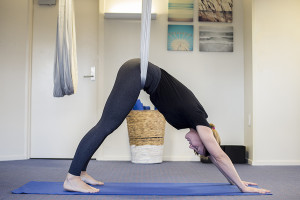
When should I stretch?
As a loose and general rule of thumb, dynamic stretches precede exercise and static stretches.
So basically stretching is best done after a warm-up.
Do you wake up stiff? A bit creaky?
Try leaping out of bed, doing dynamic stretching, then doing some gentle static stretches.
It will make a huge difference to your day and how you move for the rest of the morning.
In fact in an AntiGravity® class, we always begin with a variety of specific stretches and poses that flow together ensuring constant movement.
How long should I stretch for?
Ideally every day! (of course if you have any injuries please follow the advice of your health professional)
Before your workout, try dynamic stretches. A few rounds of 10 on each side should warm up the body nicely.
After working out, try holding a static the stretch 30-60 seconds. Don’t forget to breath!
(More on this in our next blog post )
What should it feel like?
Any stretch could feel uncomfortable at first. Try to stay though even if its just for a few seconds and you will start to feel a release.
Breath calmly and regularly through your nose and relax to the point of mild discomfort. Then you know you are getting a good stretch and reaping all the benefits we highlighted earlier!
Pain is never good; a stretch is often a balance between effort and relaxation.
Always be sure to progress slowly. If at any point you feel distress or pain, stop and seek medical advice.
What Next?
So now we know all the benefits of stretching and why adding a routine to your workout can bring your workout and performance to the next level!
We have learned some stretches we can do in the hammock and some stretches you can add to your workout to increase performance.
What stretches do you do to warm up and cool down before you train?
Let us know what your thoughts are, and if you have any questions on stretching and why it’s important, ask away!
Health and Happiness,
Freyja
This article was scientifically researched from various sources.
Written by Freyja from Float Fitness[/vc_column_text][/vc_column][/vc_row]
[vc_row][vc_column width=”1/1″][vc_column_text] Today I’m going to show you how a good friend (healthily) lost 24kgs in 12 months, despite being a full time mum with 2 young kids.
Today I’m going to show you how a good friend (healthily) lost 24kgs in 12 months, despite being a full time mum with 2 young kids.
Here’s the hard truth about parenting and exercise:
There are way too many people trying to lose weight with the “New Years Resolution” approach.
They think, “I haven’t worked out in 6 months, so I’ll just fit 6 months of exercise in the next 7 days”….
If only it were that easy…
And as a parent, trying to MAKE time is just PART of the problem.
If you’re serious about making more time for yourself and getting back into shape, you need to create a systematic approach to your goals.
Otherwise you may find that those new running shoes are only used around the house whilst watching Game Of Thrones…
Well today I’m going to show you a technique that almost guarantees you more time so you can kick start your workout goals.
Keep reading to learn:
[/vc_column_text][/vc_column][/vc_row][vc_row][vc_column width=”1/1″][vc_column_text]
I know that parents have such limited time.
I also know many women don’t want this lack of time to steer them away from their life goals, in particular their fitness goals.
I know women, who, when they’ve dedicated themselves to a goal just don’t let go. Louise (below) lost 24kgs when she dedicated herself to losing her baby weight.
[/vc_column_text][vc_empty_space height=”32px”][/vc_column][/vc_row][vc_row][vc_column width=”1/2″][vc_single_image image=”363″ border_color=”grey” img_link_target=”_self” img_size=”large” alignment=”center”][/vc_column][vc_column width=”1/2″][vc_single_image image=”182″ border_color=”grey” img_link_target=”_self” img_size=”large” alignment=”center”][/vc_column][/vc_row][vc_row][vc_column width=”1/1″][vc_empty_space height=”50″][/vc_column][/vc_row][vc_row][vc_column width=”1/1″][vc_column_text]That’s not even the best part:
You can do the EXACT same thing…even if you don’t have a budget for the gym or much free time.[/vc_column_text][vc_empty_space height=”100″][vc_column_text]
There are just 3 simple steps to the Time Machine Technique:
Step 1: Adjust your mindset to ensure success (small victories)
Step 2: Structure your day to “make more time”
Step 3: Start working on your “Machine” and get that body in shape
Here’s why you’re going to love this technique, and why it’s like a “time machine” for your workout:
Imagine you find a time machine…
If you were to go back 5 years, how would you feel?
You’d be back in shape, more confident and full of energy!
And that’s how you would feel today if you were back in shape.
It’s not your age that defines your life.
It’s the action you take that defines how you look and feel!
Suddenly, you will have the energy to do so much more with the day…..
So read on for step one.[/vc_column_text][vc_column_text]
Remember those New Years Resolution workouts?
The reason we don’t reach our fitness goals is we put so much pressure on ourselves to succeed that we feel overwhelmed and end up just giving up. We expect to be able to work out at the same intensity we did 5 years ago.
And giving up certainly feels more comfortable than continuing to fight with ourselves every day.
So here’s the thing:
Did you ever do a foreign language at school?
Let’s say you spoke French. You did further studies, you even took a field trip there and fell head over heels for a local. Then you came home and haven’t uttered a word of French for years.
If you tried to speak French again today, there’s no hope you would be at the same standard.
So if you met that same person again in the street today would you just give up, walk away and decide not to practice how to speak French?
Or would you learn a little more each day and improve gradually?
You would keep practicing of course!
So why are you judging your workouts that way?
You can’t work out like you used to. Not yet anyway…
You need to build reasonable goals and start with achievable steps.
[/vc_column_text][vc_column_text]
Tell me if this is goal setting story rings true for you:
You have this awesome goal you strive towards. Every day you work towards it…and every day you miss the target for one reason or another.
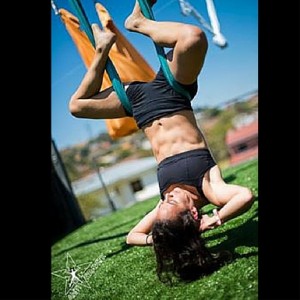
How can you keep up the willpower to keep on pushing on?
Let’s turn this on its head and realise that if you focus only on the result of your goal, every day will feel like a mini failure when you look in the mirror and don’t see a swimsuit model.
So start thinking of your goals like this instead: (because its way more fun and quicker to achieve):
Break you goals down into “chapters” or levels of success.
Each day work towards each chapter and don’t focus on anything but that chapter. The rest are irrelevant for now.
And then something strange will happen:
Each day you start to make small improvements. You see more ‘mini victories’ that push you forward.
These mini victories are your motivation to keep progressing.
By only focusing on the one chapter you stop worrying about how you’ll achieve the final goal. And you’ll actually get there faster!
Here’s what you need to do now:
Repetition is the mother of skill.
It’s as cliché as they come but its incredibly true. One of the most important parts to achieving any goal is to believe in it.
Break down your tasks and let your small victories be rewarded. Don’t defeat yourself before you have started.
In the last actionable step you broke your goals down into chapters. Now take these chapters and add your ‘can do anything’ mindset and you have a recipe for success!
So here’s what I want you to do:
Create a mantra for yourself.
Have you ever have that moment when jogging or running and in your head you hum a song to your steps?
Do you find music helps you keep your breath and not focus on the exercise too much?
Find something to fit that rhythm. Something you can repeat every morning before you get on with your day.
“I will exercise today. I will exercise tomorrow”
I know it seems cheesy but here’s what will happen:
Imagine what would happen if you do this on a daily basis? Something so simple could really change every day from the moment you read this! Remember repetition is the mother of skill, so keep going until you squash any negativity regarding getting up and working out.

This is SUPER simple.
Have you ever saved up for anything? Something you really wanted like new shoes, a jacket or even a new car? Did you keep a photo of it on your phone or keep stalking the sales page online in all your free time?
It took sooo long to save up, but you knew you wanted it. You could see yourself owning it. You could picture the situations that would happen from having it.
I have spoken to people who have had dreams about their material wants.
Take the example of a new pair of shoes.
You could probably see the shoes in your mind. The colour, the shape. You could see yourself sat at your desk or heading out for a drink and everyone saying how nice they are.
You worked hard, maybe even saved up and bought the shoes. You achieved your goal (buying the shoes) through the power of visualisation.
So you already have your mantra, now let’s try reinforcing your mantra with a visual trigger.
So do this:
Go on:
Go grab that image and save it to your phone.
Print it and stick it to your fridge.
Even easier is to find an image from any magazine and Blue-tack it to your wall.
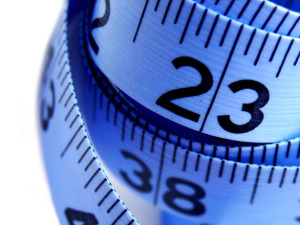
What gets measured gets managed!
It’s a well-known truth that those who do well at almost anything are the ones who focus on their goals.
But the truly successful ones are people who measure and manage each step.
By creating “benchmarks” or having small steps to work towards, you can break down your large task or weight goal into smaller chunks.
What’s your weight goal to drop?
Its important to realise that as you exercise more you will build muscle. So don’t just set a goal for weight loss.
Instead measure the changes you make everywhere on your body. Grab a tape measure and take measurements.
Then each week be sure to measure yourself. You will see a faster change in the tape measure than on the scale or in the mirror.
Remember the small victories. By measuring yourself you can stay focused and positive towards your goal.
So you can measure your progress easily, we created a PDF version of how to consistently measure your body for weight loss here:
[/vc_column_text][vc_empty_space height=”50″][vc_column_text]
One of the biggest steps my friend faces as a full time mum is finding the time to exercise. But she looks amazing! She made health her priority.
But would you like to know a secret?
It’s because she doesn’t make excuses.
She didn’t believe she could drop the weight at first. Something else always came up, or she was too tired.
Adjusting her mindset gave her the MOST free time and energy she had ever had.
So let’s take that positive mindset and discover the truth behind ‘creating more time’
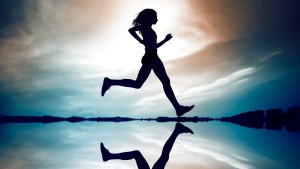
In his book “Eat the Frog” Brian Tracy talks about the best methods to be more productive.
His view on productivity is this: if your life depended on eating a frog every day, you’d probably want to do it first thing in the morning to get it over and done with, so you wouldn’t be dreading it all day long.
Make sure you do the thing you find the most difficult first thing in the morning.
All the thinking and worrying is a waste of valuable energy.
So take action and start the day as you intend to!
One of the biggest objections we hear is that you can’t afford a babysitter to look after the kids. And so you can’t make time to exercise…
So we ask – could you use your partner?
Before your partner and kids even wake up could you find an hour to grab some time to yourself and break a sweat?
I guarantee you’ll feel refreshed and organised for your day and then be there for the kids/partner/cats/dog.
Bonus of an early riser 1: Early mornings are not for everyone. But if you can get started before your brain has a chance to kick in then you can’t start thinking up excuses why not. In fact, you’ll be finished and full of spirit-lifting endorphins before you get a chance to worry!
Bonus of an early riser 2: ‘Happy hormones’ created whilst exercising can kick start your day so much better than a coffee can!
“Early to bed and early to rise makes a man healthy, wealthy, and wise”
Benjamin Franklin
As simple as it sounds, when we finally get a moment to ourselves we often stay up late and then feel too exhausted to do anything the following day.
Some days we really are exhausted, (believe me I know) but gently changing your sleeping pattern is a really effective and simple way to get started.
Early to bed and early to rise is a deciding factor in achieving your goals. Just ask any of the pioneering entrepreneurs on this list.
By structuring your sleep, you can structure your days and take charge!
Get that early morning exercise in and you’ll soon relish the pattern to your day!
Finally don’t have a job to do?
If time is a major factor, and all you have is 5 minutes, then use those 5 minutes!
If you don’t believe that, then get this:
Tim Ferriss of the famous book ‘The 4hr Body” believes that 4 hours of exercise a week is all you need to maintain a healthy and vibrant body.
One of the tactics he uses is to fill any free time with exercise (seriously, he does squats in toilet stalls!)
So you could take a leaf out his book and fill up your free time with exercise:
Schedule a whole week of workouts in advance.
Set up a specific time for your day (ideally in the morning) and stick to it. You already have your visual goal on the wall and your gym bag ready under it.

Often the quality time with friends we have is at the bar or over a bottle of wine on the sofa.
It can be easy to rely on alcohol to ‘wind down’.
Ironically exercise actually reduces our stress hormones much better than wine ever could.
So organise activities instead. Go for walks, hike up hills, or visit a waterfall. Walking is a great bonding exercise and a much better way to connect with your friends than trying to talk across a bar.
And the bonus:
You’ll do something far more rewarding like burning calories, raising endorphins and feeling great!
(And you’ll save cash)
Did you ever see the Bourne Identity? The secret agent who was ready for anything.
At the drop of a hat, he can leap through a window, fight some insurgents, land on a motorbike with his grab-bag of money and passports and be gone.
How?
He’s prepared….
Pretend you’re a secret agent and have your “Go Bag” ready at a moments notice. Take it with you in the car.
Sometimes you don’t have the time to exercise. But other times the moment will present itself and it will simply take too long to go get your gear.
Be ready at all times – you secret agent you!
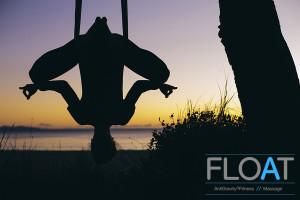
Each morning I make sure to “prime” myself for the day. I get my sweat on and listen to something motivational to get my head in the game – usually with Tony Robbins, or someone motivational.
Tony reminds me that writing down your goal is only 20% of the way.
80% of your achievement is based on your mindset. Don’t be afraid to take those small steps. You’ve already taken the first by reading this far!
[/vc_column_text][/vc_column][/vc_row][vc_row][vc_column width=”1/1″][vc_column_text]
So now you’re mentally prepared, you KNOW you can do this and you have set a time to work out, no matter how short.
Your gym bag is packed like a secret agent and you have a clear vision in your mind of how you’re going to look and most importantly feel thanks to your new mindset.
And you now understand that small actions will help towards much larger goals. Remember by changing your mindset you are 80% there.
All you need now are some simple exercises to get you started.
Getting started is paramount to the Time Machine Technique. It doesn’t matter which workout program you start as long as you start working out!
Nike hit the nail on the head with their “Just Do It!” slogan.
You can move on to new workouts and exercise programs down the road but to see results you need to pick one and work on it. There are some incredible paid and free resources available on the internet. Even better would be to commit to a personal trainer.
4 weeks is all we ask!
Let’s focus on the key exercises that are nice and easy to get back into with the focus on maximum rewards.
You may not be able to work out every day but try to keep structure to your workout routine. (What gets measured gets managed!)
Don’t forget: adequate rest for your muscles to grow and repair is more important than fitting in extra workouts!
Remember we work out so we have more energy, not so we can’t move the next day and quit the day after that. Think marathon, not sprint.
Take this sample workout if you’d like to. I’m not a personal trainer but I’ve personally seen the results of taking one day at a time through being an AntiGravity® instructor.(Remember when starting a new workout routine ALWAYS consult your doctor or health professional first! Monitor your own resistance, drink plenty of water and enjoy yourself!)
These are all explained below.
Day 1:
Cardio/ HIITtraining
Day 2:
Day 3:
Rest!
Weeks 1-2 Jogging and Walking – some advice on how to start your cardio
Nothing too crazy to begin with. By starting with small walks and jogs you will begin to increase your lung capacity. More oxygen definitely helps when you want to exercise!
When you start out you may find yourself getting a stitch or ‘burning’ lungs. This is just them getting used to working a little harder than usual.
This will also release those endorphins to help you feel GREAT as well as continue to burn calories during the day. Our goal here is not to lose weight but to start feeling great about exercise and its benefits.
Learn your limits. You need to be able to exercise again in a few days so don’t burn yourself out on day 1!
Set yourself a circuit to do. Perhaps around your block and back to the house. As you get better you can increase the number of times you complete the circuit.
The trick to remember is that even marathon runners don’t practice with 20km runs daily.
They start at 5km, then 6km the next week, then 7km the week after and upwards from there.
Build towards those goals and let your lungs get used to the work!
Weeks 3-4
Tabata Training
Now that you’re starting to jog more, its time to increase your output.
Your body needs to be pushed to grow.
But rather than increase the distance and time spent, be more efficient. Tabata is a timing method designed to break your training down into intervals. It features a repeating pattern of 90 seconds of working at low intensity followed by 30 seconds of high intensity for around 8 minutes.
You can download the timer for Iphone here for free here.
The goal is to just add small bursts of higher activity.
This will not only get the heart and lungs working harder but again burn more calories and help you reduce the amount of time you need to exercise for!
Compound Squats
Want a 6 pack? Well steer away from crunches.
Instead we’ll focus on compound movements to work your entire body. By working your legs and butt you actually burn more calories, work more muscles and tone your entire body.
The vertical movement actually engages your core to create an overall tone and definition. Here’s a little article from Nicola over at foreverfit.tv, which says it all really.
Start with:
3 (sets) x 5 (Repetitions)
i.e Do 5 squats and then rest. Repeat this 3 times.
Like anything the first time through will be difficult. But as your muscles and technique improves we will push you a little harder.
Week 2
3 (sets) x 10 (Repetitions)
Week 3
3 (sets) x 15 (Repetitions)
Week 4
3 (sets) x 20 (Repetitions)
Because your legs are a huge muscle group you can normally push them harder than other muscles. We use them every day so they get pretty strong.
But we also don’t realise our limits of what our legs can do. It’s common for beginners to overwork their legs and then not be able to walk the next day!
Remember:
SQUAT TECHNIQUE AND WALK-THROUGH HERE
Lunges
3 (sets) x 5 (Repetitions) ALTERNATE EACH SIDE
Another leg exercise. We’re focusing on the muscles you already use and have available to work out with from day 1.
Lunges are brilliant. They work your core, back, legs and cardio if done with intensity.
Week 2
3 (sets) x 10 (Repetitions)
Week 3
3 (sets) x 15 (Repetitions)
Week 4
3 (sets) x 20 (Repetitions)
Remember:
Stretch your legs after your workout!
LUNGE TECHNIQUE AND WALK-THROUGH HERE
Pushups
So far we’ve focused on legs only as they are muscles we use daily. Depending on your normal activities this may be where it gets a little difficult.
Pushups are a compound exercise and work so many muscle groups (just like squats)
Your chest, arms, shoulders back and core all get worked during a push up.
Week 1
On knees (unless able)
3 (sets) x 5 (Repetitions)
Week 2
3 (sets) x 6 (Repetitions)
Week 3
3 (sets) x 8 (Repetitions)
Week 4
3 (sets) x 10 (Repetitions)
Remember that you need to start with small increments to make sure you STICK to your goals.
Don’t overwhelm yourself and try to jump in at 3 x 25 every day until you can’t move!
Star jumps
As we’re working on cardio on separate days, you still need to warm up your body to get ready to work it!
2 (sets) x 25 (Repetitions)
That’s right – 50 star jumps to get you nice and warm and feeling awesome. This is an exercise you simply can’t do without a smile on your face.
For good form and to reduce injury to your knees, only move your legs shoulder width apart.
Remember to warm down too by stretching.
If you haven’t worked out in a while it will take time to build yourself up, so make a commitment to longevity.
So There You Have It…
When implemented, the Time Machine Technique really does make you feel 5 years younger. And it’s a simple strategy that focuses on a complete set of tools that start with just tiny changes in your day-to-day routine.
There are just 3 simple steps to the Time Machine Technique:
Step 1: Adjust your mindset to ensure success (small victories create big wins)
Step 2: Structure your day to “Make more time”
Step 3: Start working on your “Machine” and get that body in shape
Following these 6 steps creates more time and gets you feeling great and full of energy!
#1 ) Change the way you set goals by focusing on the journey rather than the result.
#2 ) Repetition is the mother of skill. Develop skills by practice and watch the result simply unfold
#3 ) Remember visualisation makes dreams a reality
#4 ) What gets measured gets managed
#5 ) Research productivity tips – workout time is everywhere!
#6 ) The real secret is just to start
Challenge yourself and become your best self!
In the meantime,
Health and Happiness,
Freyja
Float Fitness[/vc_column_text][/vc_column][/vc_row]